Enhancing Forest Growth and Yield Predictions with Airborne Laser Scanning Data: Increasing Spatial Detail and Optimizing Yield Curve Selection through Template Matching
Abstract
:1. Introduction
2. Materials and Methods
2.1. Study Area
2.2. Forest Inventory Data
2.3. Ground Plot Data
2.4. ALS Point Clouds and Metrics
2.5. Enhanced Forest Inventory Data
2.6. Growth and Yield Model
2.7. Generation of Yield Curve Templates
- —coefficient of determination of ABA-predicted attribute x; x = (HMAX, HL, QMD, V)
- —candidate yield curve chosen for attribute x
2.8. Evaluation of Uncertainty in Yield Curve Assignment
2.9. Evaluation of Attribute Projections
3. Results
3.1. Attribute Projections
3.2. Evaluation of Uncertainty in Yield Curve Template Assignment
3.3. Evaluation of Attribute Projections
4. Discussion
5. Conclusions
Acknowledgments
Author Contributions
Conflicts of Interest
References
- Avery, T.E.; Burkhart, H. Forest Measurements; McGraw-Hill: New York, NY, USA, 2002. [Google Scholar]
- Wulder, M.A.; Bater, C.W.; Coops, N.C.; Hilker, T.; White, J.C. The role of LiDAR in sustainable forest management. For. Chron. 2008, 84, 807–826. [Google Scholar] [CrossRef]
- Pretzsch, H. Forest Dynamics, Growth and Yield: From Measurement to Model; Springer: Berlin, Germany, 2009; pp. 1–39. [Google Scholar]
- Peng, C. Growth and yield models for uneven-aged stands: Past, present and future. For. Ecol. Manag. 2000, 132, 259–279. [Google Scholar] [CrossRef]
- Mäkelä, A.; Landsberg, J.O.E.; Ek, A.R.; Burk, T.E.; Ter-Mikaelian, M.; Ågren, G.I.; Oliver, C.D.; Puttonen, P. Process-based models for forest ecosystem management: Current state of the art and challenges for practical implementation. Tree Physiol. 2000, 20, 289–298. [Google Scholar] [CrossRef] [PubMed]
- White, J.C.; Wulder, M.A.; Varhola, A.; Vastaranta, M.; Coops, N.C.; Cook, B.D.; Pitt, D.; Woods, M. A best practices guide for generating forest inventory attributes from airborne laser scanning data using an area-based approach. For. Chron. 2013, 89, 722–723. [Google Scholar] [CrossRef]
- Bouvier, M.; Durrieu, S.; Fournier, R.A.; Renaud, J.-P. Generalizing predictive models of forest inventory attributes using an area-based approach with airborne LiDAR data. Remote Sens. Environ. 2015, 156, 322–334. [Google Scholar] [CrossRef]
- Næsset, E. Predicting forest stand characteristics with airborne scanning laser using a practical two-stage procedure and field data. Remote Sens. Environ. 2002, 80, 88–99. [Google Scholar] [CrossRef]
- Hyyppä, J.; Inkinen, M. Detecting and estimating attributes for single trees using laser scanner. Photogramm. J. Finl. 1999, 16, 27–42. [Google Scholar]
- Reitberger, J.; Schnörr, C.; Krzystek, P.; Stilla, U. 3D segmentation of single trees exploiting full waveform LiDAR data. ISPRS J. Photogramm. Remote Sens. 2009, 64, 561–574. [Google Scholar] [CrossRef]
- Jakubowski, M.; Li, W.; Guo, Q.; Kelly, M. Delineating Individual Trees from LiDAR Data: A Comparison of Vector- and Raster-based Segmentation Approaches. Remote Sens. 2013, 5, 4163–4186. [Google Scholar] [CrossRef]
- Maltamo, M.; Eerikainen, K.; Pitkanen, J.; Hyyppa, J.; Vehmas, M. Estimation of timber volume and stem density based on scanning laser altimetry and expected tree size distribution functions. Remote Sens. Environ. 2004, 90, 319–330. [Google Scholar] [CrossRef]
- Brosofske, K.D.; Froese, R.E.; Falkowski, M.J.; Banskota, A. A review of methods for mapping and prediction of inventory attributes for operational forest management. For. Sci. 2014, 60, 733–756. [Google Scholar] [CrossRef]
- Wulder, M.A.; Coops, N.C.; Hudak, A.T.; Morsdorf, F.; Nelson, R.; Newnham, G.; Vastaranta, M. Status and prospects for LiDAR remote sensing of forested ecosystems. Can. J. Remote Sens. 2013, 39, S1–S5. [Google Scholar] [CrossRef]
- Coops, N.C. Characterizing Forest Growth and Productivity Using Remotely Sensed Data. Curr. For. Rep. 2015, 1, 195–205. [Google Scholar] [CrossRef]
- Yu, X.; Hyyppä, J.; Kaartinen, H.; Maltamo, M. Automatic detection of harvested trees and determination of forest growth using airborne laser scanning. Remote Sens. Environ. 2004, 90, 451–462. [Google Scholar] [CrossRef]
- Hopkinson, C.; Chasmer, L.; Hall, R.J. The uncertainty in conifer plantation growth prediction from multi-temporal LiDAR datasets. Remote Sens. Environ. 2008, 112, 1168–1180. [Google Scholar] [CrossRef]
- Næsset, E.; Gobakken, T. Estimating forest growth using canopy metrics derived from airborne laser scanner data. Remote Sens. Environ. 2005, 96, 453–465. [Google Scholar] [CrossRef]
- Härkönen, S.; Tokola, T.; Packalén, P.; Korhonen, L.; Mäkelä, A. Predicting forest growth based on airborne light detection and ranging data, climate data, and a simplified process-based model. Can. J. For. Res. 2013, 43, 364–375. [Google Scholar] [CrossRef]
- Taguchi, H.; Endo, T.; Yasuoka, Y. Biomass estimation by coupling LiDAR data with forest growth model in conifer plantation. In Proceedings of the 28th Asian Association of Remote Sensing Conference, Kuala Lampur, Malaysia, 12–16 November 2007; pp. 4–6.
- Landsberg, J.J.; Waring, R.H. A generalised model of forest productivity using simplified concepts of radiation-use efficiency, carbon balance and partitioning. For. Ecol. Manag. 1997, 95, 209–228. [Google Scholar] [CrossRef]
- Falkowski, M.J.; Hudak, A.T.; Crookston, N.L.; Gessler, P.E.; Uebler, E.H.; Smith, A.M.S. Landscape-scale parametrization of a tree-level forest growth model: A k-nearest neighbor imputation approach incorporating LiDAR data. Can. J. For. Res. 2010, 40, 184–199. [Google Scholar] [CrossRef]
- Dixon, G. Essential FVS: A User’s Guide to the Forest Vegetation Simulator; Internal Report; USDA: Fort Collins, CO, USA, 2003.
- Meidinger, D.V.; Pojar, J. Ecosystems of British Columbia; British Columbia Ministry of Forests: Victoria, BC, Canada, 1991.
- Ministry of Forest Lands and Natural Resource Operations. Growth and Yield Modelling. Available online: https://www.for.gov.bc.ca/hts/growth/tipsy/tipsy_description.html (accessed on 10 June 2015).
- British Columbia Ministry of Forests. Variable Density Yield Projection; Forest Analysis and Inventory Branch: Victoria, BC, Canada, 2009.
- Ministry of Forest Lands and Natural Resource Operations. Vegetation Resources Inventory, Version 3.0; Photo Interpretation Procedures: Victoria, BC, Canada, 2014.
- Leckie, D.G.; Gillis, M.D. Forest inventory in Canada with emphasis on map production. For. Chron. 1995, 71, 74–88. [Google Scholar] [CrossRef]
- Sandvoss, M.; Mcclymont, B.; Farnden, N.C. A User’s Guide to the Vegetation Resources Inventory; Tolko Industries, Ltd.: Williams Lake, BC, Canada, 2005. [Google Scholar]
- Tompalski, P.; Coops, N.C.; White, J.C.; Wulder, M.A. Augmenting site index estimation with airborne laser scanning data. For. Sci. 2015, 61, 861–873. [Google Scholar] [CrossRef]
- Maltamo, M.; Packalén, P.; Suvanto, A.; Korhonen, K.T.; Mehtätalo, L.; Hyvönen, P. Combining ALS and NFI training data for forest management planning: A case study in Kuortane, Western Finland. Eur. J. For. Res. 2009, 128, 305–317. [Google Scholar] [CrossRef]
- Kankare, V.; Räty, M.; Yu, X.; Holopainen, M.; Vastaranta, M.; Kantola, T.; Hyyppä, J.; Hyyppä, H.; Alho, P.; Viitala, R. Single tree biomass modelling using airborne laser scanning. ISPRS J. Photogramm. Remote Sens. 2013, 85, 66–73. [Google Scholar] [CrossRef]
- Woods, M.; Pitt, D.; Penner, M.; Lim, K.; Nesbitt, D.; Etheridge, D.; Treitz, P. Operational implementation of a LiDAR inventory in Boreal Ontario. For. Chron. 2011, 87, 512–528. [Google Scholar] [CrossRef]
- Ministry of Forests, Lands & Natural Resource Operations. Glossary of Forestry Terms in British Columbia. Available online: https://www.for.gov.bc.ca/hfd/library/documents/glossary/ (accessed on 20 October 2015).
- Ministry of Forest Lands and Natural Resource Operations. Growth Relationships and Model Components. Available online: https://www.for.gov.bc.ca/hts/vri/biometric/bio_growth.html (accessed on 10 June 2015).
- Breiman, L. Random forest. Mach. Learn. 2001, 45, 5–32. [Google Scholar] [CrossRef]
- Smith, J.H.G.; Ker, J.W.; Czizmazia, J. Economics of Reforestation of Douglas-fir, Western Hemlock and Western Red Cedar in the Vancouver Forest District; University of British Columbia: Vancouver, BC, Canada, 1961. [Google Scholar]
- Minore, D. Western Redcedar: A Literature Review; USDA: Portland, OR, USA, 1983.
- Tompalski, P.; Coops, N.C.; White, J.C.; Wulder, M.A.; Pickell, P.D. Estimating Forest Site Productivity Using Airborne Laser Scanning Data and Landsat Time Series. Can. J. Remote Sens. 2015, 41, 232–245. [Google Scholar] [CrossRef]
- Pickell, P.D.; Hermosilla, T.; Coops, N.C.; Masek, J.G.; Franks, S.; Huang, C. Monitoring anthropogenic disturbance trends in an industrialized boreal forest with Landsat time series. Remote Sens. Lett. 2014, 5, 783–792. [Google Scholar] [CrossRef]

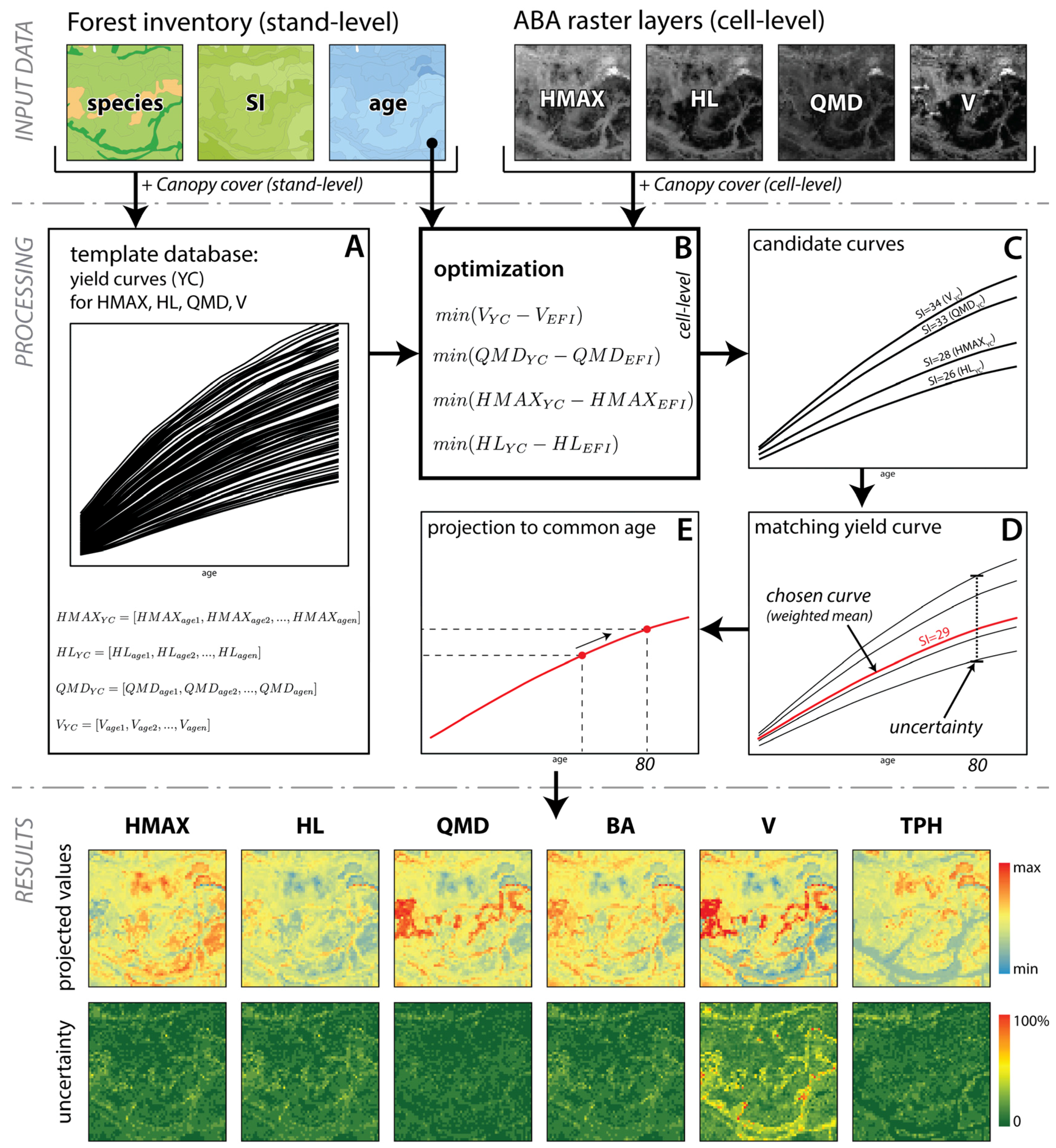
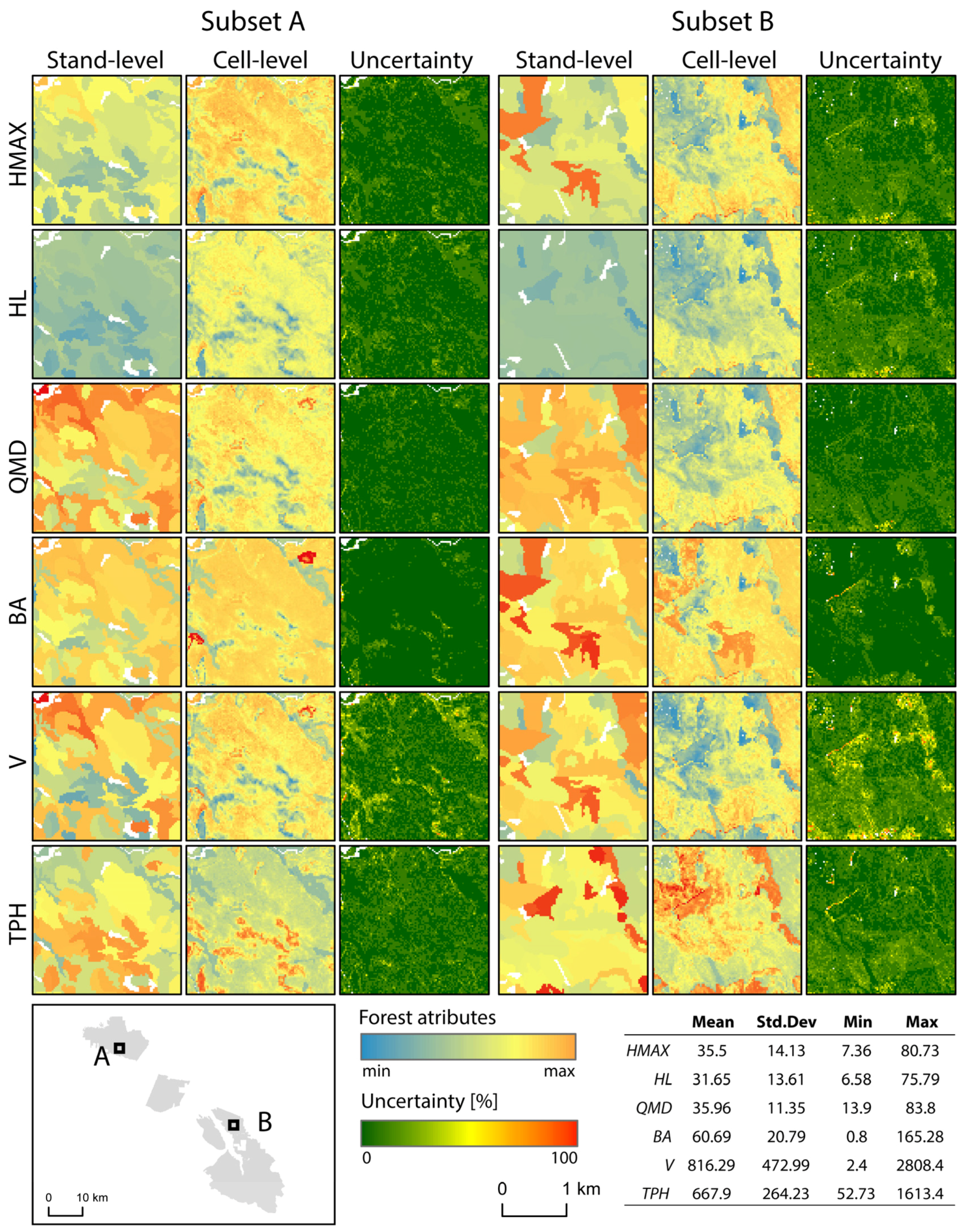

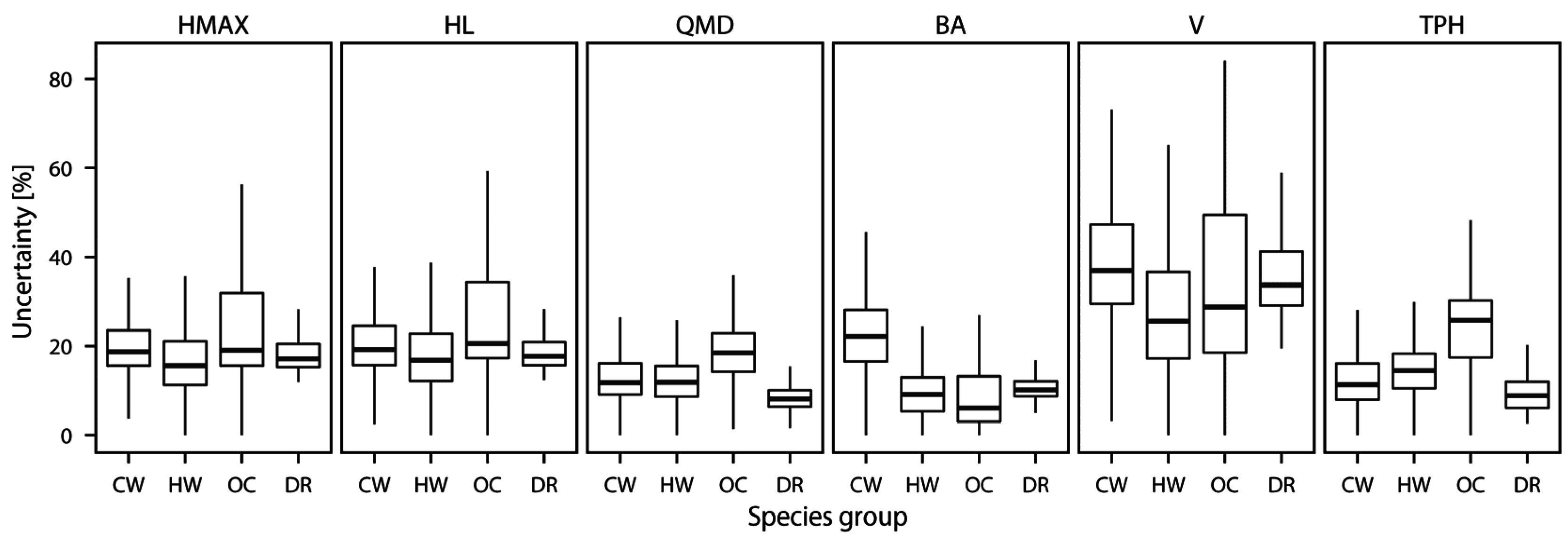
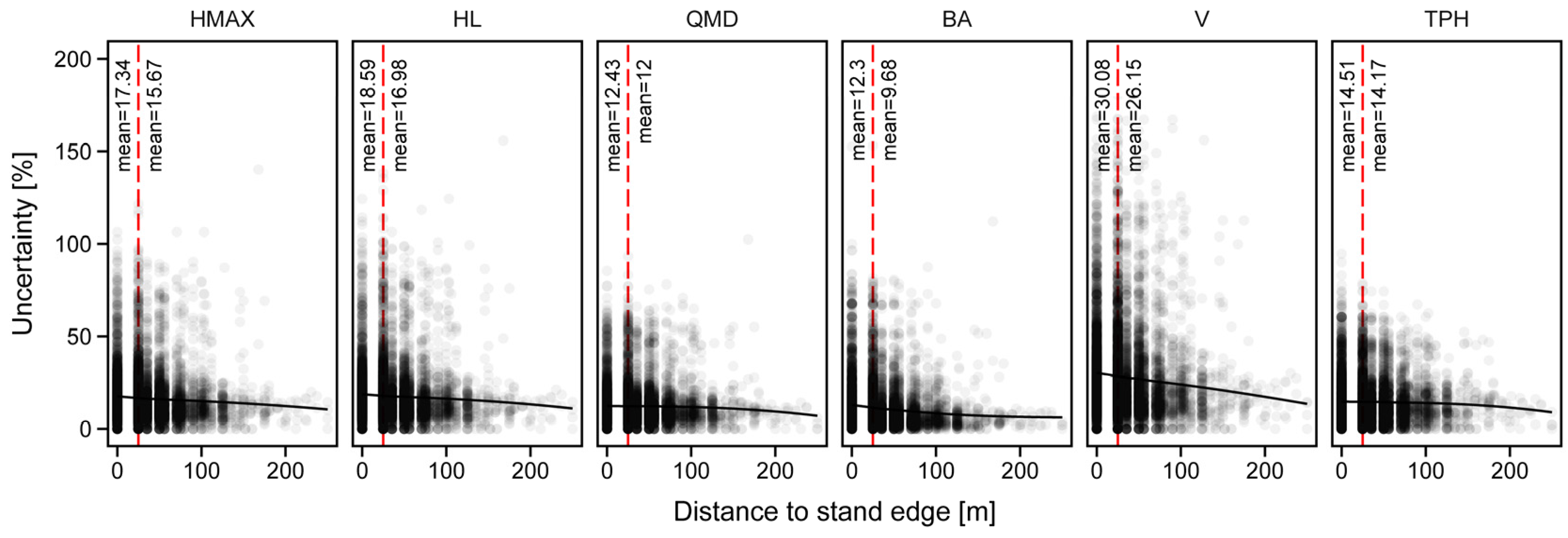
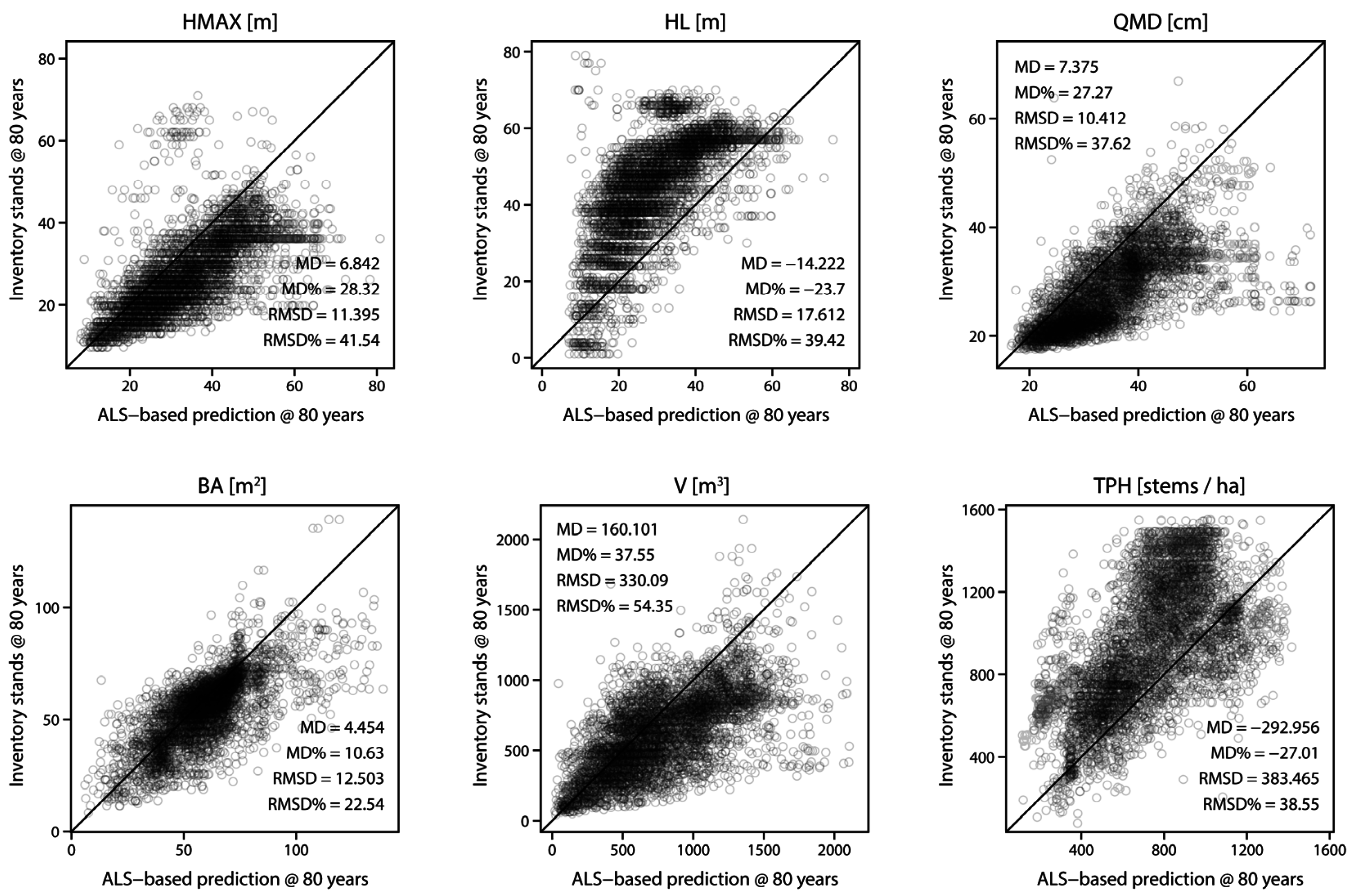
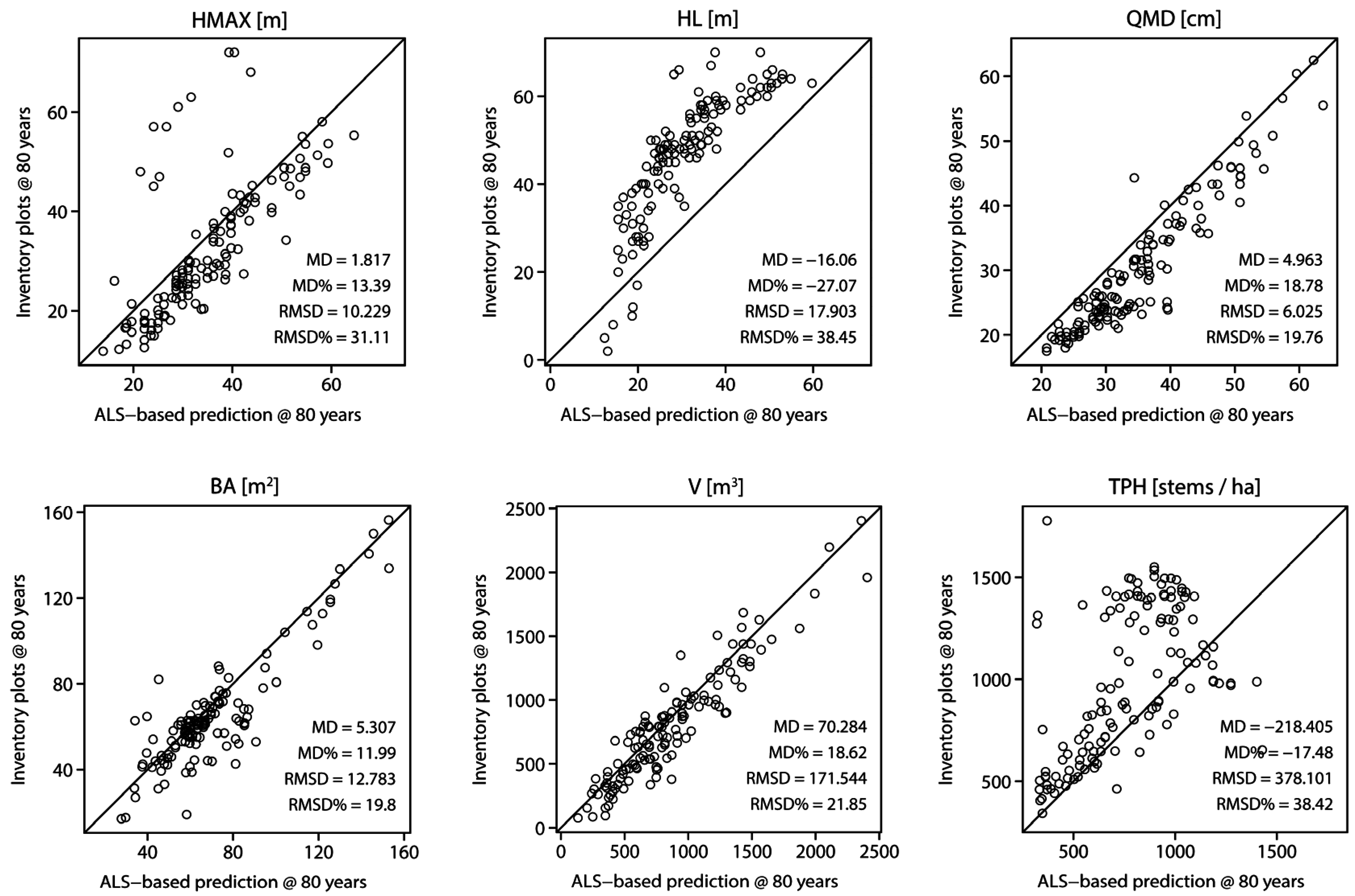

| Species Group | Common Name | Scientific Name | Species Code | Total Area | Mean Area (ha) | Number of Stands | Stand Age (Years) | Stand Height (m) | Site Index (m) | |||||
|---|---|---|---|---|---|---|---|---|---|---|---|---|---|---|
| ha | % | # | % | mean | σ | mean | σ | mean | σ | |||||
| HW | western hemlock | Tsuga heterophylla Sarg. | Hw | 42,673.2 | 72.1 | 6.6 | 6489 | 67.9 | 132.3 | 118.4 | 22.2 | 16.4 | 22.2 | 6.6 |
| mountain hemlock | Tsuga mertensiana (Bong.) Carr. | Hm | 1742.9 | 2.9 | 8.3 | 211 | 2.2 | 242.9 | 47.5 | 23.2 | 5.7 | 6.8 | 2.5 | |
| group subtotal | 44,416.1 | 75.1 | 6.6 | 6700 | 70.1 | 135.8 | 118.4 | 22.2 | 16.2 | 21.7 | 7.1 | |||
| CW | western redcedar | Thuja plicata Donn ex D. Don | Cw | 7379.2 | 12.5 | 4.9 | 1493 | 15.6 | 215.4 | 149.6 | 21.2 | 15.9 | 16.9 | 4.8 |
| yellow-cedar | Chamaecyparis nootkatensis (D. Don) Spach | Yc | 2521.4 | 4.3 | 6.7 | 376 | 3.9 | 251.8 | 127.6 | 16.5 | 9.4 | 11.7 | 5.1 | |
| group subtotal | 9900.6 | 16.7 | 5.3 | 1869 | 19.6 | 222.7 | 146.1 | 20.2 | 14.9 | 15.9 | 5.3 | |||
| OC | Douglas-fir | Pseudotsuga menziesii (Mirb.) Franco | Fd | 740.0 | 1.3 | 7.4 | 100 | 1.0 | 116.2 | 101.0 | 24.0 | 15.7 | 27.4 | 5.9 |
| amabilis fir | Abies amabilis Douglas ex J. Forbes | Ba | 1199.0 | 2.0 | 5.3 | 225 | 2.4 | 106.4 | 101.5 | 17.8 | 17.0 | 21.0 | 6.0 | |
| Sitka spruce | Picea sitchensis (Bong.) Trautv. & C. A. Mey. | Ss | 940.5 | 1.6 | 6.9 | 137 | 1.4 | 62.3 | 76.1 | 16.4 | 15.6 | 31.5 | 6.7 | |
| group subtotal | 2880.7 | 4.9 | 6.2 | 464 | 4.9 | 95.3 | 96.7 | 18.7 | 16.5 | 25.4 | 7.8 | |||
| DR | red alder | Alnus rubra Bong. | Dr | 1953.3 | 3.3 | 3.7 | 526 | 5.5 | 53.1 | 17.2 | 21.2 | 7.0 | 24.7 | 5.8 |
| total for all stands | 59,150.7 | 100.0 | 6.2 | 9559 | 100.0 | 146.2 | 127.7 | 21.6 | 15.6 | 20.9 | 7.3 | |||
| Species Group | n | HL (m) | QMD (cm) | V (m3) | |||
|---|---|---|---|---|---|---|---|
| Mean | σ | Mean | σ | Mean | σ | ||
| CW | 18 | 30.6 | 6.1 | 47.7 | 11.2 | 1107.9 | 466.6 |
| HW | 100 | 34.2 | 10.4 | 42.1 | 15.6 | 1032.1 | 598.6 |
| OC | 7 | 31.6 | 9.1 | 35.2 | 12.6 | 933.8 | 439.0 |
| DR | 8 | 24.1 | 7.6 | 27.6 | 8.1 | 462.3 | 323.3 |
| Overall | 133 | 33.0 | 10.0 | 41.6 | 15.1 | 1002.9 | 575.5 |
| Variable | Species | R2 | * | RMSE | RMSE% |
|---|---|---|---|---|---|
| HMAX (m) | All | 0.95 | 0.00 | 2.53 | 6.65 |
| HL (m) | All | 0.94 | 0.01 | 2.40 | 7.93 |
| QMD (cm) | HW | 0.71 | −0.82 | 8.95 | 20.49 |
| CW | 0.37 | −0.67 | 7.91 | 17.68 | |
| OC | 0.29 | −0.07 | 13.34 | 29.79 | |
| DR | 0.79 | −0.60 | 2.61 | 8.56 | |
| V (m3) | HW | 0.68 | 10.12 | 334.36 | 34.13 |
| CW | 0.48 | −33.47 | 303.71 | 33.54 | |
| OC | 0.54 | −34.56 | 276.10 | 31.89 | |
| DR | 0.76 | 11.07 | 128.28 | 26.30 |
| Forest Stand Attribute | Species Group | r | MD | MD% | RMSD | RMSD% |
|---|---|---|---|---|---|---|
| HMAX (m) | CW | 0.72 | 4.48 | 23.55 | 10.53 | 53.17 |
| HW | 0.80 | 8.23 | 31.60 | 11.07 | 39.45 | |
| OC | −0.02 | −7.27 | −8.25 | 19.17 | 41.84 | |
| DR | 0.22 | 6.56 | 27.61 | 9.61 | 34.42 | |
| all | 0.76 | 6.84 | 28.32 | 11.39 | 41.54 | |
| HL (m) | CW | 0.62 | −14.77 | −22.68 | 20.22 | 57.12 |
| HW | 0.81 | −12.90 | −21.91 | 15.47 | 34.19 | |
| OC | 0.74 | −15.34 | −30.54 | 17.76 | 35.72 | |
| DR | 0.14 | −32.66 | −50.06 | 33.07 | 50.67 | |
| all | 0.74 | −14.22 | −23.70 | 17.61 | 39.42 | |
| QMD (cm) | CW | 0.66 | 5.57 | 21.23 | 11.47 | 43.26 |
| HW | 0.83 | 8.15 | 30.14 | 10.45 | 38.36 | |
| OC | 0.67 | 4.85 | 16.61 | 9.15 | 27.03 | |
| DR | 0.12 | 3.93 | 13.12 | 5.77 | 17.36 | |
| all | 0.78 | 7.37 | 27.27 | 10.41 | 37.62 | |
| BA (m2·ha−1) | CW | 0.79 | 13.19 | 28.99 | 21.18 | 38.11 |
| HW | 0.69 | 2.34 | 5.48 | 8.85 | 15.78 | |
| OC | 0.29 | 5.45 | 17.59 | 20.59 | 30.11 | |
| DR | 0.19 | 5.39 | 19.52 | 9.12 | 27.76 | |
| all | 0.73 | 4.45 | 10.63 | 12.50 | 22.54 | |
| V (m3·ha−1) | CW | 0.67 | 107.39 | 35.90 | 402.12 | 83.64 |
| HW | 0.69 | 170.07 | 35.26 | 311.47 | 49.09 | |
| OC | 0.73 | 145.94 | 37.65 | 355.02 | 40.68 | |
| DR | 0.24 | 207.45 | 81.01 | 301.57 | 78.77 | |
| all | 0.67 | 160.10 | 37.55 | 330.09 | 54.35 | |
| TPH (stems·ha−1) | CW | 0.38 | −73.64 | −5.98 | 263.66 | 27.23 |
| HW | 0.81 | −371.62 | −34.36 | 420.83 | 40.08 | |
| OC | 0.44 | −72.38 | −5.74 | 282.54 | 35.70 | |
| DR | 0.09 | −38.60 | −5.88 | 101.13 | 26.11 | |
| all | 0.69 | −292.96 | −27.01 | 383.46 | 38.55 |
© 2016 by the authors; licensee MDPI, Basel, Switzerland. This article is an open access article distributed under the terms and conditions of the Creative Commons Attribution (CC-BY) license (http://creativecommons.org/licenses/by/4.0/).
Share and Cite
Tompalski, P.; Coops, N.C.; White, J.C.; Wulder, M.A. Enhancing Forest Growth and Yield Predictions with Airborne Laser Scanning Data: Increasing Spatial Detail and Optimizing Yield Curve Selection through Template Matching. Forests 2016, 7, 255. https://doi.org/10.3390/f7110255
Tompalski P, Coops NC, White JC, Wulder MA. Enhancing Forest Growth and Yield Predictions with Airborne Laser Scanning Data: Increasing Spatial Detail and Optimizing Yield Curve Selection through Template Matching. Forests. 2016; 7(11):255. https://doi.org/10.3390/f7110255
Chicago/Turabian StyleTompalski, Piotr, Nicholas C. Coops, Joanne C. White, and Michael A. Wulder. 2016. "Enhancing Forest Growth and Yield Predictions with Airborne Laser Scanning Data: Increasing Spatial Detail and Optimizing Yield Curve Selection through Template Matching" Forests 7, no. 11: 255. https://doi.org/10.3390/f7110255






